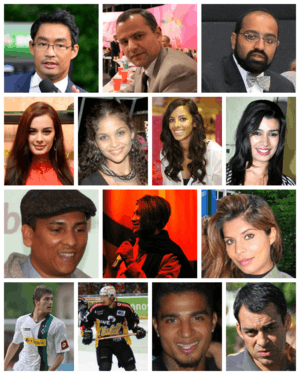Asians in Germany
|
1st row (21st century Politics): Philipp Rösler • Sebastian Edathy • Josef Winkler 2nd row (21st century Film): Evelyn Sharma • Ayesha Kapur • Collien Fernandes • Mink Brar 3rd row (21st century Music): Xavier Naidoo • Sabrina Setlur • Indira Weis 4th row (21st century Sports): Roman Neustädter • Martin Hyun • Kevin-Prince Boateng • Robin Dutt | |
| Total population | |
|---|---|
| (2.0% of the German population)) | |
| Regions with significant populations | |
| Berlin, Hamburg, Munich, Frankfurt am Main, Düsseldorf, Hanover, Ruhrgebiet, Cologne, Leipzig, Dresden, Rostock | |
| Languages | |
| German · Asian languages | |
| Religion | |
| predominantly Buddhism, Irreligion and Islam but also Christianity, Hinduism and Sikhism |
Asians in Germany or German Asians (German: Deutsch-Asiaten) are German citizens of full or partial Asian descent. The term Asian German is also applied to foreign residents of Asian origin living in the Federal Republic of Germany. German Asians have been present in Germany in small numbers since the 19th century and originate primarily from countries like Vietnam, China, Thailand, India, Afghanistan, Kazakhstan, Sri Lanka, South Korea, Japan or the Philippines. Although Germany's official census data doesn't collect specific data on ethnicity or race, the number of people with an Asian "migrant background" is listed in statistical reports. As of 2011, there were approximately 1,890,000 people in Germany who descended from inhabitants of Southeast Asia, East Asia, Central Asia or South Asia. These numbers do not include Western Asians such as Turks, Jews, Arabs or Iranians, however, they contain certain groups like Afghans or ethnic Russians from Central Asian countries who are not specifically "Asian" by culture.
History
Before World War II
The first mentioned Asians in Germany were Chinese. In 1822 two Cantonese-speaking seafarers, Feng Yaxing and Feng Yanxue came to Berlin.[3] They were employed as stoker on steamships in Hamburg and Bremen. During the mid to late 19th and early 20th century plenty of seamen and students resided in the Hamburg district of St. Pauli, forming a Chinatown.[4] Due to the Nazi regime, most of the Chinese population had to leave in the 1930s to escape discrimination.
Present
In western Germany, a lot of Vietnamese people arrived in the 1960s or 1970s as refugees from the Vietnam War. The comparatively larger Vietnamese community in eastern Germany traces its origins to assistance agreements between the GDR and the North Vietnamese government. Under these agreements, guest workers from Vietnam were brought to East Germany, where they soon made up the largest immigrant group and were provided with technical training. Following the fall of the Berlin Wall, many stayed in Germany. Since the early 1990s there has been an influx of Thai people, South Koreans, Indonesians and Filipinos coming to Germany as nurses, au pairs or employees. In addition, illegal immigration from Vietnam via Eastern Europe is increasing significantly in the East German states.[5] Furthermore, there are far more Thai and Filipino women than men in Germany, while the reverse holds true for Chinese and Indians. The Vietnamese community which now forms the largest group of Asians in Germany has a more equal male-female ratio.
Demographic distribution
According to the German "Mikrozensus 2011" there were about 1.8 Million people with an Asian migrant background living in Germany. Of those about 600,000 were of Southeast Asian descent (primarily from Vietnam or Thailand).[6]
The distribution of German Asians by federal state is as follows:
| State | Number of Asians | % of State population |
|---|---|---|
| North Rhine-Westphalia | |
|
| Baden-Württemberg | |
|
| Bavaria | |
|
| Hesse | |
|
| Berlin | |
|
| Lower Saxony | |
|
| Rhineland-Palatinate | |
|
| Hamburg | |
|
| Schleswig-Holstein | |
|
| Bremen | |
|
| Neue Länder (former East Germany) | |
|
| Saarland | |
|
See also
- Demographics of Germany
- Vietnamese people in Germany
- Chinese people in Germany
- East Asian British
- Asian American
- Asian Canadian
References
Notes
Sources
- Gütinger, Erich (2004), Die Geschichte Der Chinesen in Deutschland: Ein Überblick über die ersten 100 Jahre ab 1822, Waxmann Verlag, ISBN 978-3-8309-1457-0
Further reading
- Hillmann, Felicitas, "Riders on the storm: Vietnamese in Germany's two migration systems", in Spaan, Ernst; Hillmann, Felicitas; van Naerssen, Ton, Asian Migrants and European Labour Markets, pp. 80–100, ISBN 978-0-415-36502-4
